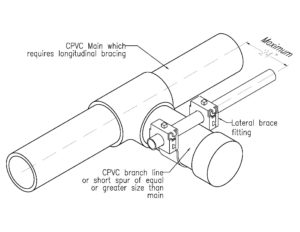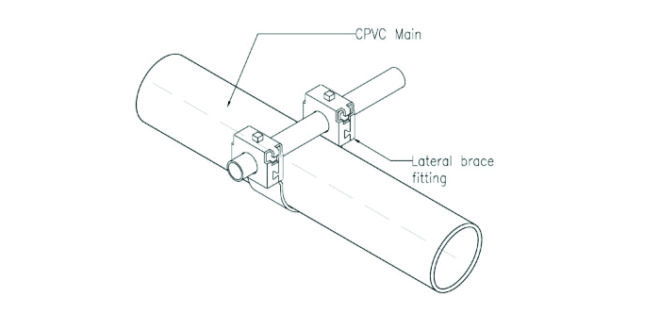Don’t Overlook This Requirement
Fire sprinkler systems in areas subjected to seismic activity – earthquakes! – must be provided with a means to protect them from damage. The ability of the seismic protection to keep the sprinkler system operational after an earthquake is a matter of some significance and is well worth the attention provided in the National Fire Protection Association (NFPA) standards.
Contractors are increasingly utilizing CPVC piping in systems protecting light hazard and residential occupancies. The positives and negatives of using this material in fire sprinkler systems are best discussed another time. The point of this article is that all pipe installed per NFPA 13, Standard for the Installation of Sprinkler Systems, is required to have seismic protection when the seismic design category from either the building code or the American Society of Civil Engineers’ (ASCE) 7 designates the building as needing to address this issue. When the design is to follow NFPA 13R, Standard for the Installation of Sprinkler Systems in Low-Rise Residential Occupancies, the guidance in that document mandates that the “hanging and bracing methods shall comply with NFPA 13” [2016 edition, section 6.13].
This article will only discuss the lateral and longitudinal bracing for CPVC piping. It is worth noting that there is no allowable omission of bracing for the type of pipe identified in the standard. So, the requirements of section 9.3.5.5.1 requiring lateral bracing on “all feed and cross mains regardless of size” [emphasis added] as well as “branch line pipe 2½ in. and larger” applies, as does the provision in section 9.3.5.6 for longitudinal bracing being required for “feed and cross mains.”
Lateral bracing must be provided at intervals not exceeding 40 ft-0 in. on center [section 9.3.5.5.2.2], within 6 ft-0 in. of the end of the main [section 9.3.5.5.5], and the maximum load FPW which the braces transmit to the piping must not exceed the values in Table 9.3.5.5.2(g) for CPVC. For example, when lateral bracing is provided on a 2-in. CPVC main, with braces spaced more than 30 ft-0 in. and not more than 35 ft-0 in. apart, the maximum FPW must not exceed 87 pounds.
Additionally, longitudinal bracing must be provided on feed and cross mains at a distance not more than 40 ft-0 in. from the end of the main [section 9.3.5.6.3] and at an interval not exceeding 80 ft-0 in. on center [section 9.3.5.6.1].
There are two items which are mistakenly applied to allow the omission of lateral bracing and both are related. When pipes are individually supported within 6 in. of the structure lateral bracing can be omitted per section 9.3.5.5.10.2(1). Piping supported with CPVC pipe straps – regardless of the manufacturer – are not the equivalent to pipe being individually supported within 6 in. of the structure by hangers. Although not explicitly stated, this allowance applies only to approved hangers as NFPA allows piping to be supported listed components. While the use of pipe straps conforms with their listing, none of that hardware has been tested and listed to achieve this goal, and they can’t be used to allow omission of lateral seismic bracing. Further, the use of such straps is not the equivalent of the U-type hooks keeping the pipe tight to the structure as noted in section 9.3.5.5.11. The straps are not U-type hooks. And it’s best to keep in mind that many site locations which require seismic protection will most likely have a CP value which exceeds 0.50. Such a value does not permit the omission of lateral bracing on mains, per section 9.3.5.5.10.2(4).
Currently, most of the manufacturers of seismic bracing hardware have a fitting to attach to CPVC piping which will provide lateral bracing. An isometric example of such lateral bracing is provided. (See Figure 1 at top of this article.) This is based on the brace member (pipe, angle, flat, rod, etc.) meeting the limitations provided in Tables 9.3.5.11.8(a)-(c) for the material to be used, the length of the brace and the angle of the brace from vertical. Further, the maximum capacities in Tables 9.3.5.12.2(a)-(i) for the methods used to fasten the brace to the structure must not be exceeded.

However, at the time of this writing, no manufacturer has developed hardware which specifically provides longitudinal bracing for CPVC. It’s easy to see why when you consider how longitudinal braces normally work. The pipe attachment must clamp down sufficiently on the pipe, in order to keep the main from moving or sliding within the attachment. The CPVC material is not capable of resisting the stress of the force required to stop such movement. In order to provide longitudinal bracing, the use of a lateral brace within 24 in. of the centerline of the pipe to be braced is acceptable if the pipe where the lateral brace is attached is of equal or greater size than the pipe requiring bracing. This is allowed per 9.3.5.5.8. (See Figure 2.)
In summary, when seismic bracing is required for a fire sprinkler system, the use of CPVC piping does not allow the omission of such bracing.
 ABOUT THE AUTHOR: Ken Wagoner, C.F.P.E., C.W.B.S.P, S.E.T. is a 1977 graduate of Bethany College (Kansas), and owner of Parsley Consulting, located in Escondido, California. He has 37 years of experience in automatic sprinkler system and fire alarm system design, plan review, and construction management. He is an AFSA-designated alternate representative to the NFPA 1031 committee, principal member of the Hanging and Bracing Committee of NFPA 13, and past chairman of the NFPA 24 and 291 committees. Wagoner has published numerous articles on seismic bracing, hydraulic calculations, system design and the plan review process; has presented online virtual seminars, and teaches classes sponsored by AFSA and the San Diego Fire Protection Association (SDFPA). He is an active member of AFSA, NFPA, and SDFPA.
ABOUT THE AUTHOR: Ken Wagoner, C.F.P.E., C.W.B.S.P, S.E.T. is a 1977 graduate of Bethany College (Kansas), and owner of Parsley Consulting, located in Escondido, California. He has 37 years of experience in automatic sprinkler system and fire alarm system design, plan review, and construction management. He is an AFSA-designated alternate representative to the NFPA 1031 committee, principal member of the Hanging and Bracing Committee of NFPA 13, and past chairman of the NFPA 24 and 291 committees. Wagoner has published numerous articles on seismic bracing, hydraulic calculations, system design and the plan review process; has presented online virtual seminars, and teaches classes sponsored by AFSA and the San Diego Fire Protection Association (SDFPA). He is an active member of AFSA, NFPA, and SDFPA.
IMPORTANT NOTICE: The article and its content is not a Formal Interpretation issued pursuant to NFPA Regulations. Any opinion expressed is the personal opinion of the author and presenter and does not necessarily present the official position of the NFPA and its Technical Committee
 Sprinkler Age A Publication of the American Fire Sprinkler Association
Sprinkler Age A Publication of the American Fire Sprinkler Association
